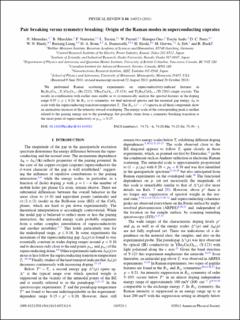Please use this identifier to cite or link to this item:
https://doi.org/10.21256/zhaw-3506| Publication type: | Article in scientific journal |
| Type of review: | Peer review (publication) |
| Title: | Pair breaking versus symmetry breaking : origin of the Raman modes in superconducting cuprates |
| Authors: | Munnikes, N. Muschler, B. Venturini, Francesca Tassini, L. Prestel, W. Ono, Shimpei Ando, Yoichi Peets, D. C. Hardy, W. N. Liang, Ruixing Bonn, D. A. Damascelli, A. Eisaki, H. Greven, M. Erb, A. Hackl, R. |
| DOI: | 10.21256/zhaw-3506 10.1103/PhysRevB.84.144523 |
| Published in: | Physical Review B |
| Volume(Issue): | 84 |
| Issue: | 144523 |
| Issue Date: | 2011 |
| Publisher / Ed. Institution: | American Physical Society |
| ISSN: | 2469-9950 2469-9969 1098-0121 1550-235X 0556-2805 0163-1829 |
| Language: | English |
| Subjects: | Infrared spectroscopy; Raman spectroscopy; Superconductor; Cuprate |
| Subject (DDC): | 530: Physics |
| Abstract: | We performed Raman scattering experiments on superconductivity-induced features in Bi2Sr2(Ca1−xYx)Cu2O8+δ (Bi-2212), YBa2Cu3O6+x (Y-123), and Tl2Ba2CuO6+δ (Tl-2201) single crystals. The results in combination with earlier ones enable us to systematically analyze the spectral features in the doping range 0.07⩽p⩽0.24. In B2g (xy) symmetry, we find universal spectra and the maximal gap energy Δ0 to scale with the superconducting transition temperature Tc. The B1g (x2−y2) spectra in all three compounds show an anomalous increase of the intensity toward overdoping. The energy scale of the corresponding peak is neither related to the pairing energy nor to the pseudogap, but possibly stems from a symmetry breaking transition at the onset point of superconductivity at psc2≃0.27. |
| URI: | https://digitalcollection.zhaw.ch/handle/11475/2639 |
| Fulltext version: | Published version |
| License (according to publishing contract): | Licence according to publishing contract |
| Departement: | School of Engineering |
| Organisational Unit: | Institute of Applied Mathematics and Physics (IAMP) |
| Appears in collections: | Publikationen School of Engineering |
Files in This Item:
| File | Description | Size | Format | |
|---|---|---|---|---|
| Munnikes_Raman_PRB.PDF | 1.31 MB | Adobe PDF |  View/Open |
Show full item record
Munnikes, N., Muschler, B., Venturini, F., Tassini, L., Prestel, W., Ono, S., Ando, Y., Peets, D. C., Hardy, W. N., Liang, R., Bonn, D. A., Damascelli, A., Eisaki, H., Greven, M., Erb, A., & Hackl, R. (2011). Pair breaking versus symmetry breaking : origin of the Raman modes in superconducting cuprates. Physical Review B, 84(144523). https://doi.org/10.21256/zhaw-3506
Munnikes, N. et al. (2011) ‘Pair breaking versus symmetry breaking : origin of the Raman modes in superconducting cuprates’, Physical Review B, 84(144523). Available at: https://doi.org/10.21256/zhaw-3506.
N. Munnikes et al., “Pair breaking versus symmetry breaking : origin of the Raman modes in superconducting cuprates,” Physical Review B, vol. 84, no. 144523, 2011, doi: 10.21256/zhaw-3506.
MUNNIKES, N., B. MUSCHLER, Francesca VENTURINI, L. TASSINI, W. PRESTEL, Shimpei ONO, Yoichi ANDO, D. C. PEETS, W. N. HARDY, Ruixing LIANG, D. A. BONN, A. DAMASCELLI, H. EISAKI, M. GREVEN, A. ERB und R. HACKL, 2011. Pair breaking versus symmetry breaking : origin of the Raman modes in superconducting cuprates. Physical Review B. 2011. Bd. 84, Nr. 144523. DOI 10.21256/zhaw-3506
Munnikes, N., B. Muschler, Francesca Venturini, L. Tassini, W. Prestel, Shimpei Ono, Yoichi Ando, et al. 2011. “Pair Breaking versus Symmetry Breaking : Origin of the Raman Modes in Superconducting Cuprates.” Physical Review B 84 (144523). https://doi.org/10.21256/zhaw-3506.
Munnikes, N., et al. “Pair Breaking versus Symmetry Breaking : Origin of the Raman Modes in Superconducting Cuprates.” Physical Review B, vol. 84, no. 144523, 2011, https://doi.org/10.21256/zhaw-3506.
Items in DSpace are protected by copyright, with all rights reserved, unless otherwise indicated.